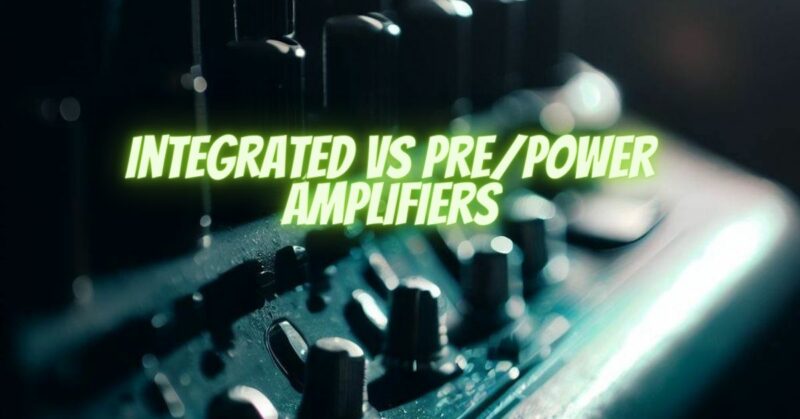When it comes to building a high-quality audio system, the choice between integrated and separate preamplifiers (preamps) and power amplifiers (power amps) is a pivotal decision that can greatly influence your sound, flexibility, and overall listening experience. In this article, we’ll delve into the considerations, advantages, and trade-offs of integrated and pre/power amplifier setups, helping you make an informed choice that aligns with your audio goals and preferences.
Integrated Amplifiers: All-in-One Excellence
Advantages:
- Simplicity: Integrated amplifiers combine both preamplification and power amplification in a single chassis, simplifying your setup and reducing the number of components.
- Compactness: If space is limited, integrated amplifiers are an efficient solution that provides the necessary amplification without the need for separate units.
- Cost-Efficiency: Integrated amplifiers often offer better value for money compared to purchasing separate preamps and power amps, making them an attractive option for those on a budget.
- Matching Components: Integrated amplifiers are designed and optimized to work together, ensuring compatibility and synergy between preamplification and power amplification stages.
Considerations:
- Customization Limitations: Integrated amplifiers may offer limited options for customization and upgradeability compared to separate preamp and power amp units.
- Specific Needs: If you require specialized features or have high-performance demands, an integrated solution might not fulfill all your requirements.
Pre/Power Amplifiers: Tailored Performance
Advantages:
- Customizable Components: With separate preamp and power amp units, you have the freedom to select components that match your specific preferences and requirements.
- Optimized Performance: Separating preamplification and power amplification stages can lead to improved sonic performance and reduced interference between components.
- Upgrade Flexibility: You can upgrade individual components, such as the preamp or power amp, without needing to replace the entire unit.
- Specialized Features: Separate preamp and power amp units often offer more advanced features, connectivity options, and greater control over your audio setup.
Considerations:
- Cost and Space: Investing in separate preamp and power amp units can be more expensive and take up more space compared to an integrated solution.
- Component Matching: While separate units offer customization, careful consideration is needed to ensure that the preamp and power amp complement each other for optimal performance.
Choosing the Right Path
- Integrated Amplifier: Opt for an integrated amplifier if you’re looking for an all-in-one solution that offers simplicity, space efficiency, and cost-effectiveness. This is ideal for entry-level setups or situations where simplicity is paramount.
- Pre/Power Amplifier: Choose separate preamp and power amp units if you’re seeking tailored performance, upgrade flexibility, and the ability to customize components to meet specific audio preferences. This is a great option for audiophiles and those who prioritize advanced features.
The decision between integrated amplifiers and separate preamp/power amp units hinges on your audio goals, budget, space availability, and desire for customization. Both options offer distinct advantages that cater to different needs. By understanding the nuances of each setup and assessing your priorities, you can select the solution that aligns perfectly with your sonic aspirations, creating an audio system that delivers exceptional sound quality and a satisfying listening experience.


